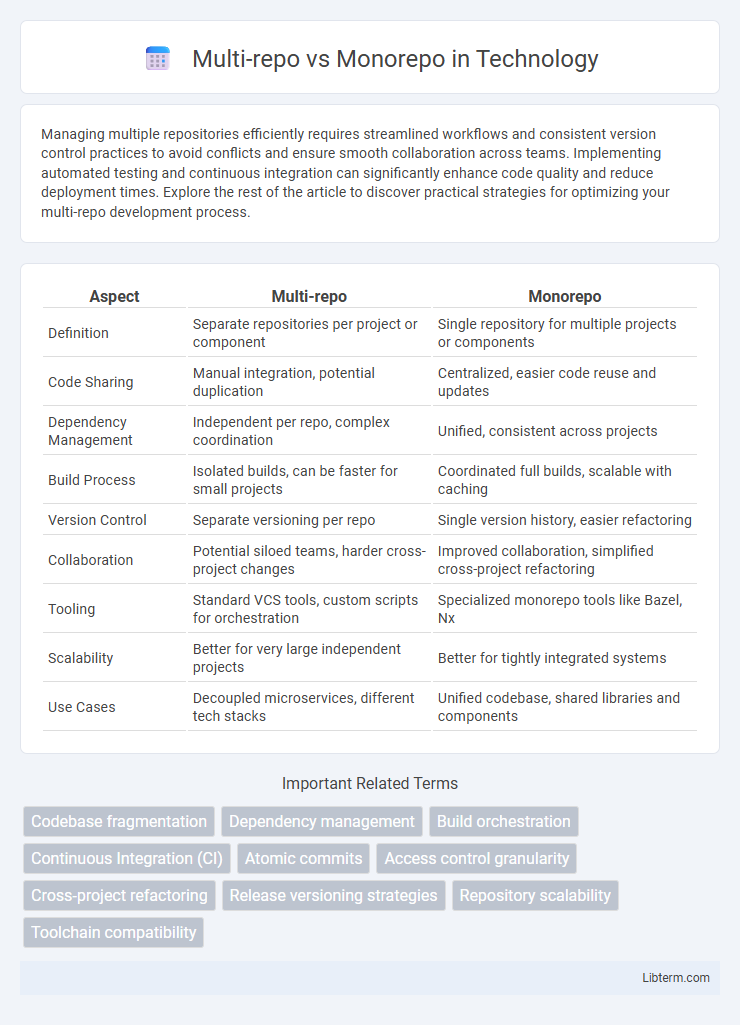Managing multiple repositories efficiently requires streamlined workflows and consistent version control practices to avoid conflicts and ensure smooth collaboration across teams. Implementing automated testing and continuous integration can significantly enhance code quality and reduce deployment times. Explore the rest of the article to discover practical strategies for optimizing your multi-repo development process.
Table of Comparison
| Aspect | Multi-repo | Monorepo |
|---|---|---|
| Definition | Separate repositories per project or component | Single repository for multiple projects or components |
| Code Sharing | Manual integration, potential duplication | Centralized, easier code reuse and updates |
| Dependency Management | Independent per repo, complex coordination | Unified, consistent across projects |
| Build Process | Isolated builds, can be faster for small projects | Coordinated full builds, scalable with caching |
| Version Control | Separate versioning per repo | Single version history, easier refactoring |
| Collaboration | Potential siloed teams, harder cross-project changes | Improved collaboration, simplified cross-project refactoring |
| Tooling | Standard VCS tools, custom scripts for orchestration | Specialized monorepo tools like Bazel, Nx |
| Scalability | Better for very large independent projects | Better for tightly integrated systems |
| Use Cases | Decoupled microservices, different tech stacks | Unified codebase, shared libraries and components |
Introduction to Codebase Management Strategies
Multi-repo and Monorepo represent two distinct codebase management strategies, each influencing collaboration, deployment, and scaling differently. Multi-repo involves managing separate repositories for different projects or components, facilitating independent version control and targeted access control. Monorepo consolidates all projects into a single repository, enhancing code sharing, unified dependency management, and simplified refactoring across teams.
Defining Monorepo and Multi-repo Architectures
Monorepo architecture consolidates multiple projects or codebases into a single repository, enabling streamlined dependency management and unified version control. Multi-repo architecture divides projects into separate repositories, each managed independently to enhance modularity and selective access control. Choosing between monorepo and multi-repo depends on factors such as team size, deployment complexity, and the need for coordinated development workflows.
Key Differences Between Monorepo and Multi-repo
Monorepo stores multiple projects within a single repository, enabling unified version control, simplified dependency management, and streamlined code sharing across teams. Multi-repo separates projects into distinct repositories, offering greater autonomy for teams, easier access control, and targeted versioning per project. Monorepos excel in large organizations requiring tight integration, while multi-repos benefit smaller, independent teams prioritizing modularity and scalability.
Advantages of Monorepo Approach
Monorepo approach centralizes all codebases in a single repository, enhancing collaboration through unified version control and streamlined dependency management. It simplifies code reuse and refactoring by providing consistent access to shared libraries and components across teams. Continuous integration and deployment pipelines benefit from monorepo's holistic view, enabling faster builds and comprehensive testing across projects.
Benefits of Multi-repo Structure
Multi-repo structure enhances codebase modularity by isolating projects into separate repositories, enabling independent versioning and deployment cycles. This separation simplifies access control and reduces the risk of merge conflicts, promoting more efficient collaboration across distributed development teams. Multi-repo also improves build times and scalability by allowing targeted updates without the overhead of rebuilding an entire monolithic repository.
Challenges and Drawbacks of Monorepo
Monorepos face scalability issues as repository size grows, leading to slower build times and increased complexity in version control. Managing dependencies and access control becomes difficult, potentially causing conflicts and hindering team autonomy. Debugging and maintaining a large codebase requires sophisticated tooling to avoid bottlenecks and ensure efficient collaboration.
Common Pitfalls in Multi-repo Setups
Multi-repo setups often face challenges like dependency management complexity, version inconsistencies, and fragmented code visibility, leading to integration difficulties. Teams may struggle with synchronization issues across repositories, resulting in broken builds and delayed development cycles. Inefficient cross-repository communication and duplicated effort are common pitfalls that can hinder project scalability and maintainability.
When to Choose Monorepo Over Multi-repo
Monorepo is ideal when a unified codebase improves collaboration, dependency management, and consistent versioning across multiple projects. Large organizations with interdependent modules benefit from simplified refactoring, streamlined CI/CD pipelines, and centralized governance. When teams handle tightly coupled components requiring synchronized updates, monorepos enhance code visibility and reduce integration overhead compared to multi-repo setups.
Industry Use Cases and Examples
Tech giants like Google and Facebook leverage monorepos for unified code management, enabling efficient collaboration and streamlined dependency handling across vast projects. In contrast, companies such as Amazon and Netflix adopt multi-repo strategies to maintain service autonomy and agile deployment in microservices architectures. Enterprises in financial services often prefer multi-repos for regulatory compliance and codebase isolation, while open-source projects like Babel utilize monorepos to simplify version control and contributor coordination.
Best Practices for Repository Management
Effective repository management for multi-repo environments emphasizes modularity, clear ownership, and independent deployment cycles, enabling teams to work autonomously and reduce interdependencies. Monorepo strategies prioritize unified version control, streamlined code sharing, and consistent tooling to maintain coherence across projects while simplifying refactoring and cross-project changes. Implementing automated testing, access controls, and CI/CD pipelines tailored to the chosen repository model ensures scalable and efficient development workflows.
Multi-repo Infographic

 libterm.com
libterm.com